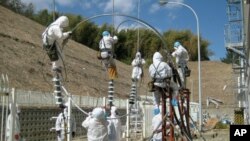The United States has not suffered a devastating earthquake for more than 100 years, and a new report says Americans wrongly believe they are earthquake-ready. The report from the National Research Council, an advisory body to the U.S. government, says recent events have revealed vulnerabilities.
The study's authors say Hurricane Katrina, which devastated New Orleans and the U.S. Gulf Coast in 2005, showed the United States is not resilient enough to bounce back quickly from a major natural disaster in an urban area.
The study, which was compiled by a dozen seismic experts, says earthquakes in the United States have been moderate to strong in recent decades, or have occurred in sparsely populated areas. The panel cited a recent earthquake exercise in Los Angeles, which showed that a magnitude 7.8 quake would result in staggering losses.
Most of the report was written prior to Japan's March 11 earthquake of magnitude nine, but panel chair Robert Hamilton says events there show how one problem can trigger another.
"In Japan, the earthquake triggered a tsunami and the tsunami knocked out the power, and the power being out made the nuclear reactor vulnerable," noted Hamilton. "And so a lot of times, when people plan for these events, they do not anticipate a compound event made up of cascading problems that build up."
The report recommends an 18-point plan for implementing the U.S. Strategic Earthquake Hazards Reduction Program, which was established by Congress in 1977. The report calls for better public education, creating short-term forecasting and early warning systems, improving building design for earthquake resilience and devising better techniques to retrofit old buildings. It also calls for enhanced earthquake simulations and evaluation of critical infrastructure, including electricity, highways and water systems.
Chairman Hamilton says the nation also needs to expand its focus beyond earthquake-prone states like California.
"For example, in the central Mississippi Valley area, there were three magnitude-eight earthquakes in 1811 and 1812," added Hamilton. "And there has not been a high level of activity ever since then. So there is a real complacency about addressing the earthquake threat in that area, and there are just a lot of vulnerable buildings."
He says parts of the eastern United States are also vulnerable. For example, Hamilton says in the United States, building codes and land-use plans are implemented and enforced at the local level, and local communities are reluctant to spend on a problem that occurs every one or two centuries.
"They have a lot of other things to worry about, and money is scarce and it is hard to convince people that they should put money into something that may not happen in their lifetime," Hamilton explained. "But still, the vulnerability exists."
Seismic experts say history teaches us to expect the unexpected.
The committee's proposals span 20 years. The report notes some measures are being implemented already, and it recommends the United States spend $300 million per year during the next five years to become more earthquake-resilient.












